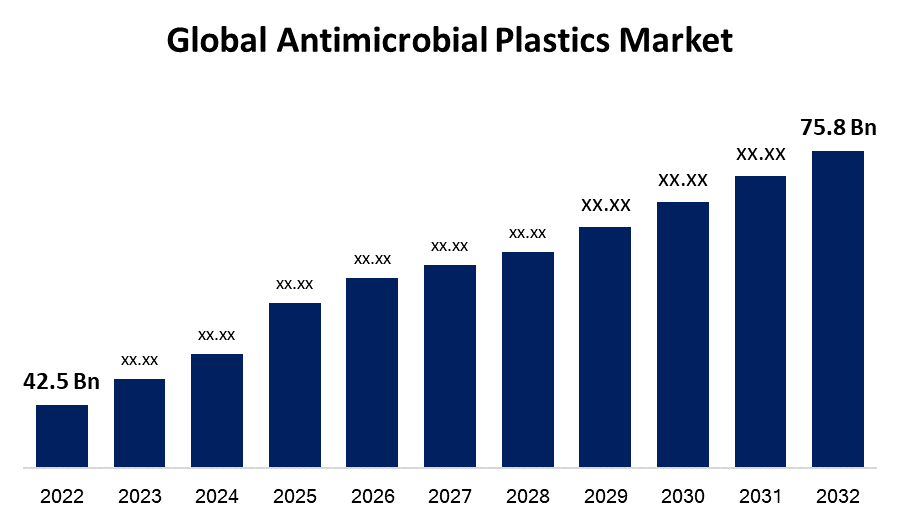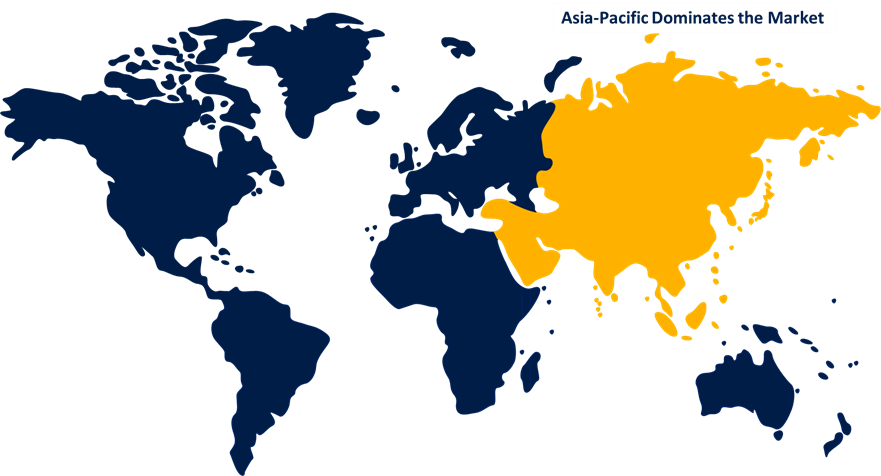Global Antimicrobial Plastics Market Size, Share, and COVID-19 Impact, By Product (Commodity Plastics, Engineering Plastics, High-performance Plastics), By End User (Medical Healthcare, Packaging, Electrical Electronics, Automotive, Building Construction, Food Beverage, Others), by Region (North America, Europe, Asia-Pacific, Latin America, Middle East, and Africa), Analysis and Forecast 2022 - 2032.
Industry: Chemicals & MaterialsGlobal Antimicrobial Plastics Market Insights Forecasts to 2032
- The Antimicrobial Plastics Market Size was valued at USD 42.5 Billion in 2022.
- The Market Size is Growing at a CAGR of 8.6% from 2022 to 2032
- The Worldwide Antimicrobial Plastics Market Size is expected to reach USD 75.8 Billion by 2032
- Europe is expected To Grow the fastest during the forecast period

Get more details on this report -
The Global Antimicrobial Plastics Market Size is expected to reach USD 75.8 Billion by 2032, at a CAGR of 8.6% during the forecast period 2022 to 2032.
Antimicrobial plastics are plastics that have been treated or modified to prevent the growth of microorganisms like bacteria, fungus, and viruses. These plastics have additives or coatings that emit antimicrobial agents, stopping hazardous microbes on their surfaces from growing and surviving. These plastics' antimicrobial qualities can be helpful in a variety of situations when it's important to keep things clean, stop diseases from spreading, or avoid the growth of dangerous germs. In medical devices, hospital equipment, and healthcare facilities, antimicrobial plastics are frequently employed. By preventing bacterial growth on surfaces, these materials improve patient safety by lowering the risk of healthcare-associated infections.
Impact of COVID-19 On the Global Antimicrobial Plastics Market
The antimicrobial plastics market is just one of the many industries that have been significantly impacted by the COVID-19 outbreak. Inhibiting the growth of microorganisms like bacteria, viruses, and fungi is the goal of antimicrobial plastics. These plastics have a wide range of uses, including in consumer items, packaging, healthcare facilities, and automobiles. In the healthcare industry, demand for antimicrobial polymers increased as a result of the pandemic. The manufacture of medical devices, personal protective equipment (PPE), and hospital surfaces has made substantial use of these plastics. The need for antimicrobial materials has been driven by the requirement for improved cleanliness practises in healthcare settings. Due to lockdowns, travel restrictions, and reduced manufacturing capabilities, the antimicrobial plastics market, like many other industries, experienced supply chain disruptions. These delays had an impact on the manufacture and supply of antimicrobial plastics, resulting in temporary shortages and higher costs. Increased research and development efforts in the area of antimicrobial polymers have been motivated by the epidemic. Numerous businesses are making investments in the creation of new and enhanced materials with increased antibacterial characteristics. The objective is to develop polymers with antiviral properties that are specifically efficient against viruses like SARS-CoV-2 while also being effective against bacteria.
Global Antimicrobial Plastics Market Report Coverage
| Report Coverage | Details |
|---|---|
| Base Year: | 2022 |
| Market Size in 2022: | USD 42.5 Billion |
| Forecast Period: | 2022-2032 |
| Forecast Period CAGR 2022-2032 : | 8.6% |
| 2032 Value Projection: | USD 75.8 Billion |
| Historical Data for: | 2018-2021 |
| No. of Pages: | 200 |
| Tables, Charts & Figures: | 110 |
| Segments covered: | By Product, By End User, y Region |
| Companies covered:: | Ticona Engineering Polymers, The Dow Chemical Company, Microban International, King Plastic Corporation, Parx Plastics N.V., Milliken Chemical, BASF SE, Biocote, Bayer MaterialScience AG, and Doeflex Vitapol |
| Pitfalls & Challenges: | COVID-19 Empact, Challenge, Future, Growth, & Analysis |
Get more details on this report -
Key Market Drivers
The demand for products that prevent the growth of microorganisms has increased as hygiene awareness and the significance of infection prevention have grown. Due to their constant defence against bacteria, viruses, and other pathogens, antimicrobial polymers give a practical answer to this demand. The antimicrobial plastics market has been mostly driven by the healthcare sector. In order to lower the risk of healthcare-associated illnesses, antimicrobial polymers are frequently utilised in medical devices, equipment, and surfaces in healthcare facilities. The need for antimicrobial polymers in the healthcare industry is anticipated to rise as hospitals and clinics place more emphasis on infection control. Numerous consumer goods and packaging materials use antimicrobial polymers. Consumers are increasingly looking for items that offer antimicrobial protection due to the rising emphasis on cleanliness and hygiene in daily life. To give an extra layer of defence against microbial contamination, antimicrobial plastics are used in products including food packaging, home appliances, personal care items, and electronics.
Key Market Challenges
Assuring the antibacterial properties of plastics are durable and effective over the long term is one of the issues. Antimicrobial compounds may lose some of their effectiveness over time, necessitating regular replacement or upkeep. To solve this problem, antimicrobial polymers must be created that can remain effective for the duration of the product's lifecycle. Regulations and standards are applied to antimicrobial polymers to assure their effectiveness and safety. Particularly with the introduction of new antimicrobial technology and additives, compliance with these rules can be difficult and time-consuming. To make sure their products match the required standards, businesses must manage regulatory requirements. Due to the inclusion of antimicrobial chemicals and the additional production procedures required, antimicrobial plastics may be more expensive than conventional plastics. Manufacturers and end users may struggle with this cost disparity, particularly in price-sensitive sectors of the economy.
Market Segmentation
Product Insights
Commodity Plastics accounted the largest market share over the forecast period
On the basis of product, the global antimicrobial plastics market is segmented into Commodity Plastics, Engineering Plastics, High-performance Plastics. Among these, commodity plastics accounted the largest market share over the forecast period. Numerous causes have fueled the need for antimicrobial polymers in the consumer market. First of all, in light of the COVID-19 pandemic in particular, consumers have become more aware of health and hygiene. The demand for antimicrobial products that can stop the spread of bacteria and germs has surged as a result of this. Antimicrobial qualities in food packaging have received more attention as a way to increase product shelf life and preserve freshness. As a result, antimicrobial films and coatings for plastic packaging materials have been created.
End Use Insights
The healthcare segment is dominating the market over the forecast period
Based on the end user, the global antimicrobial plastics market is segmented into building and construction, automotive and transportation, packaging, healthcare, food and beverage, textile, consumer goods, and others. Among these, the healthcare segment is dominating the market over the forecast period. Hospitals and other healthcare facilities are very concerned about healthcare-associated infections (HAIs). By preventing the growth of bacteria and other germs on surfaces and equipment, antimicrobial polymers reduce the incidence of HAIs. The need for antimicrobial plastics has expanded due to the expansion of healthcare facilities, particularly in emerging nations, for a variety of applications, including hospital furniture and medical equipment.
Regional Insights
Asia Pacific holds the highest market share over the forecast period

Get more details on this report -
Asia Pacific region is dominating the market with the highest market share over the forecast period. The demand for antimicrobial plastics in many industries is being driven by the region's enormous population, growing urbanisation, and growing awareness of hygiene and infection control. The demand for packaged food and processed goods has increased due to the region's expanding population and increasing disposable incomes. In order to increase food safety and the shelf life of perishable foods, antimicrobial plastics are being utilised more frequently in food packaging.
Europe, on the other hand is witnessing the fastest market growth over the forecast period. Patient safety and infection control are major priorities in the European healthcare industry. To reduce the risk of healthcare-associated infections (HAIs) and preserve a clean environment, antimicrobial plastics are frequently utilised in medical devices, equipment, hospital furniture, and surfaces. Antimicrobial plastics are in higher demand in the European packaging business due to factors like food safety laws, consumer preferences for hygienic packaging, and the need to increase product shelf life. In applications where microbial contamination must be controlled, antimicrobial plastics are utilised in food packaging, pharmaceutical packaging, and other uses.
Recent Market Developments
- In March 2021, Saniconcentrate, an additive technique, was developed by Parx Materials. With the use of this technology, antimicrobial polymers that can thwart the growth of dangerous germs and viruses can be created.
List of Key Companies
- Ticona Engineering Polymers
- The Dow Chemical Company
- Microban International
- King Plastic Corporation
- Parx Plastics N.V.
- Milliken Chemical
- BASF SE
- Biocote
- Bayer MaterialScience AG
- Doeflex Vitapol
Market Segment
This study forecasts revenue at global, regional, and country levels from 2019 to 2032. Spherical Insights has segmented the global Antimicrobial Plastics Market based on the below-mentioned segments:
Antimicrobial Plastics Market, Product Analysis
- Commodity Plastics
- Engineering Plastics
- High-performance Plastics
Antimicrobial Plastics Market, End User Analysis
- Building and construction
- Automotive and transportation
- Packaging
- Healthcare
- Food and beverage
- Textile
- Consumer goods
- Others
Antimicrobial Plastics Market, Regional Analysis
- North America
- US
- Canada
- Mexico
- Europe
- Germany
- Uk
- France
- Italy
- Spain
- Russia
- Rest of Europe
- Asia Pacific
- China
- Japan
- India
- South Korea
- Australia
- Rest of Asia Pacific
- South America
- Brazil
- Argentina
- Rest of South America
- Middle East & Africa
- UAE
- Saudi Arabia
- Qatar
- South Africa
- Rest of Middle East & Africa
Frequently Asked Questions (FAQ)
-
1.What is the market size of Antimicrobial Plastics Market?The global Antimicrobial Plastics Market is expected to grow from USD 42.5 Billion in 2022 to USD 75.8 Billion by 2032, at a CAGR of 8.6% during the forecast period 2022-2032.
-
2.Who are the key market players of Antimicrobial Plastics Market?Some of the key market players of Ticona Engineering Polymers, The Dow Chemical Company, Microban International, King Plastic Corporation, Parx Plastics N.V., Milliken Chemical, BASF SE, Biocote, Bayer MaterialScience AG, Doeflex Vitapol.
-
3.Which segment hold the largest market share?Consumer goods segment holds the largest market share is going to continue its dominance.
-
4.Which region is dominating the Antimicrobial Plastics Market?Asia Pacific is dominating the Antimicrobial Plastics Market with the highest market share.
Need help to buy this report?